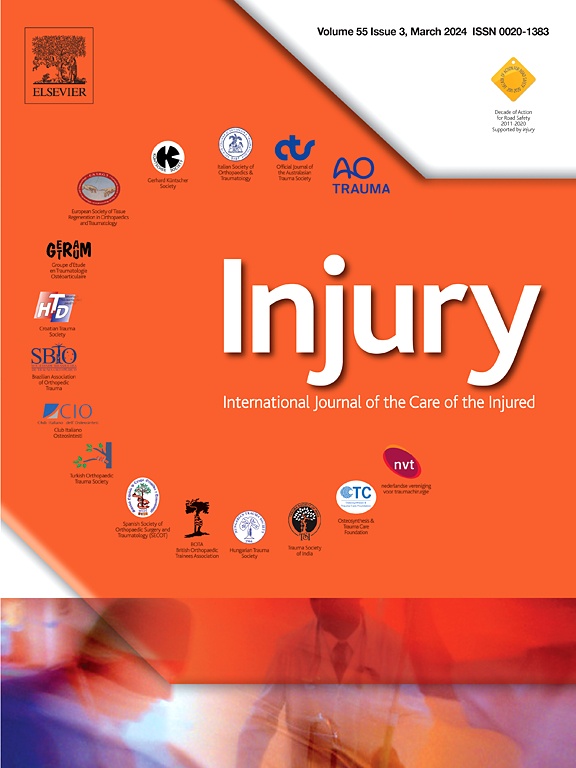
Reamed and minimally reamed nailing display no difference in clinical outcome

Reamed and minimally reamed nailing display no difference in clinical outcome
Reamed versus minimally reamed nailing: a prospectively randomised study of 100 patients with closed fractures of the tibia
Injury. 2011 Sep;42 Suppl 4:S17-21. doi: 10.1016/S0020-1383(11)70007-9Did you know you're eligible to earn 0.5 CME credits for reading this report? Click Here
Synopsis
100 patients were randomized to examine whether minimal reaming would lead to similar beneficial effects as extensive reaming in the treatment of closed tibial fractures. Patients received either reamed nailing (up to 12 mm inserting an 11 mm tibial nail) or minimally reamed nailing (up to 10 mm inserting a 9 mm tibial nail). Assessment at 52 weeks revealed that there was no difference in clinical outcome between the two treatments. However, there appeared to be a tendency towards earlier fracture healing in the conventional/extensive reamed group.
Was the allocation sequence adequately generated?
Was allocation adequately concealed?
Blinding Treatment Providers: Was knowledge of the allocated interventions adequately prevented?
Blinding Outcome Assessors: Was knowledge of the allocated interventions adequately prevented?
Blinding Patients: Was knowledge of the allocated interventions adequately prevented?
Was loss to follow-up (missing outcome data) infrequent?
Are reports of the study free of suggestion of selective outcome reporting?
Were outcomes objective, patient-important and assessed in a manner to limit bias (ie. duplicate assessors, Independent assessors)?
Was the sample size sufficiently large to assure a balance of prognosis and sufficiently large number of outcome events?
Was investigator expertise/experience with both treatment and control techniques likely the same (ie.were criteria for surgeon participation/expertise provided)?
Yes = 1
Uncertain = 0.5
Not Relevant = 0
No = 0
The Reporting Criteria Assessment evaluates the transparency with which authors report the methodological and trial characteristics of the trial within the publication. The assessment is divided into five categories which are presented below.
2/4
Randomization
2/4
Outcome Measurements
2/4
Inclusion / Exclusion
4/4
Therapy Description
3/4
Statistics
Detsky AS, Naylor CD, O'Rourke K, McGeer AJ, L'Abbé KA. J Clin Epidemiol. 1992;45:255-65
The Fragility Index is a tool that aids in the interpretation of significant findings, providing a measure of strength for a result. The Fragility Index represents the number of consecutive events that need to be added to a dichotomous outcome to make the finding no longer significant. A small number represents a weaker finding and a large number represents a stronger finding.
Why was this study needed now?
The first treatment option for closed tibial fractures involves stabilization with reamed intramedullary nails; however, this treatment has been suggested to be detrimental to the endosteal circulation, potentially leading to higher rates of infection. One method to avoid this complication while still maintaining the osteogenic properties of reamed nailing involves minimal reaming. The authors who performed minimal reaming in an animal study suggested that this treatment could be advantageous for the stabilization of tibial fractures. Thus, this study aimed to compare the clinical effects of reamed and minimally reamed intramedullary nailing in closed tibial fractures.
What was the principal research question?
Did minimal reaming lead to similar clinical benefits when compared to extensive reaming for the treatment of tibial fractures, assessed at 52 weeks?
What were the important findings?
- The rate of complications was low in both groups, with 3 cases (6%) of additional fractures in the reamed group, and 7 cases (14%) in the minimally reamed group; the difference was not significant.
- While no superficial wound infection was observed, compartment syndrome occurred in 11 patients (22%) in the reamed group and 13 patients (26%) of the minimally reamed group; however, this difference was not significant.
- Union was observed earlier in the reamed group (17 weeks) in comparison to the minimally reamed group (19 weeks), where more reamed patients displayed healed fractures by 16 weeks (57%) versus minimally reamed patients (43%); however, this difference was not statistically significant.
- Although the reamed group restarted activities (such as running and training) earlier than the minimally reamed group, the difference was not statistically significance.
- No significant difference was observed between the two groups in respect to the range of motion of the knee, ankle, and subtalar joints.
- Pain (VAS) continually improved in the reamed group (4.0 +/- 1.8 at week 4 to 2.0 +/- 1.8 at week 52) and the minimally reamed group (4.0 +/- 2.3 at week 4 to 2.0 +/- 1.9 at week 52); there was no significant difference between both groups.
- In regards to knee pain complaints, more patients in the reamed group (17) expressed no pain compared to those in the minimally reamed group (12); however, this difference was not statistically significant.
What should I remember most?
This study revealed that there were no significant differences in clinical outcome between extensive reaming and minimal reaming for tibial fractures. Both treatments led to similar improvements in pain and displayed no significant difference in complications. However, there appeared to be a tendency towards earlier fracture healing in the conventional/extensive reamed group.
How will this affect the care of my patients?
This study suggests that minimal reaming provides similar clinical benefits as extensive reaming. Future research will require a larger sample size to further examine these two treatments for closed tibial fractures.
Learn about our AI Driven
High Impact Search Feature
Our AI driven High Impact metric calculates the impact an article will have by considering both the publishing journal and the content of the article itself. Built using the latest advances in natural language processing, OE High Impact predicts an article’s future number of citations better than impact factor alone.
Continue



 LOGIN
LOGIN

Join the Conversation
Please Login or Join to leave comments.